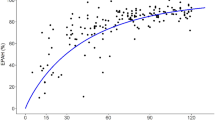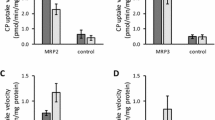Abstract
Purpose
The objective of this work was to demonstrate that clinical OAT1-mediated DDIs can be predicted using physiologically based pharmacokinetic (PBPK) modeling.
Methods
LY404039 is a metabotropic glutamate receptor 2/3 agonist and the active moiety of the prodrug pomaglumetad methionil (LY2140023). After oral administration, pomaglumetad methionil is rapidly taken up by enterocytes via PEPT1 and once absorbed, converted to LY404039 via membrane dehydropeptidase 1 (DPEP1). LY404039 is renally excreted by both glomerular filtration and active secretion and in vitro studies showed that the active secretion of LY404039 was mediated by the organic anion transporter 1 (OAT1). Both clinical and in vitro data were used to build a PBPK model to predict OAT1-mediated DDIs.
Results
In vitro inhibitory potencies (IC50) of the known OAT inhibitors, probenecid and ibuprofen, were determined to be 4.00 and 2.63 µM, respectively. Subsequently, clinical drug-drug interaction (DDI) study showed probenecid reduced the renal clearance of LY404039 by 30 to 40%. The PBPK bottom-up model, predicted a renal clearance that was approximately 20% lower than the observed one. The middle-out model, using an OAT1 relative activity factor (RAF) of 3, accurately reproduced the renal clearance of LY404039 and pharmacokinetic (PK) changes of LY404039 in the presence of probenecid.
Conclusions
OAT1- mediated DDIs can be predicted using in vitro measured IC50 and PBPK modeling. The effect of ibuprofen was predicted to be minimal (AUC ratio of 1.15) and not clinically relevant.




Similar content being viewed by others
Data Availability
The datasets generated during and/or analyzed during the current study are available from the corresponding author on reasonable request.
Abbreviations
- AE:
-
Adverse event
- AUC:
-
Area under the concentration time curve
- AUC0-∞ :
-
AUC from time 0 extrapolated to infinity
- CLr :
-
Renal clearance
- Cmax :
-
Maximum observed plasma concentration
- DDI:
-
Drug-drug interaction
- fmet :
-
Fraction of the metabolite formed
- GFR:
-
Glomerular filtration rate
- HEK:
-
Human embryonic kidney
- HEK-VC:
-
HEK vector control
- ITC:
-
International Transporter Consortium
- kfmet :
-
The first order metabolite formation rate constant
- KHB:
-
Krebs Henseleit buffer
- OAT:
-
Organic anion transporter
- PEPT1:
-
Peptide transporter 1
- PKPD:
-
Pharmacokinetics and pharmacodynamics
- PBPK:
-
Physiologically based pharmacokinetic
- RAF:
-
Relative activity factor
- t1/2 :
-
Elimination half-life
- tlag :
-
The lag time
- tmax , :
-
Time of maximum observed plasma concentration
References
Pak YA, Long AJ, Annes WF, Witcher JW, Knadler MP, Ayan-Oshodi MA, Mitchell MI, Leese P, Hillgren KM. In vitro and clinical evaluations of the drug-drug interaction potential of a metabotropic glutamate 2/3 receptor agonist prodrug with intestinal peptide transporter 1. Drug Metab Dispos. 2017;45(2):137–44.
Moulton RD, Ruterbories KJ, Bedwell DW, Mohutsky MA. In vitro characterization of the bioconversion of pomaglumetad methionil, a novel metabotropic glutamate 2/3 receptor agonist peptide prodrug. Drug Metab Dispos. 2015;43(5):756–61.
Annes WF, Long A, Witcher JW, Ayan-Oshodi MA, Knadler MP, Zhang W, Mitchell MI, Cornelissen K, Hall SD. Relative contributions of presystemic and systemic peptidases to oral exposure of a novel metabotropic glutamate 2/3 receptor agonist (LY404039) after oral administration of prodrug pomaglumetad methionil (LY2140023). J Pharm Sci. 2015;104(1):207–14.
Witcher JLA, Seger ME, Wessels AM, Annes WF, Knadler M, Marbury TC, Ayan-Oshodi M. In Effects of renal impairment on LY2140023 and LY404039 pharmacokinetics, Clinical Pharmacology & Therapeutics, 2013; pp S100-S101.
Hillgren KM, Keppler D, Zur AA, Giacomini KM, Stieger B, Cass CE, Zhang L. International Transporter, C., Emerging transporters of clinical importance: an update from the International Transporter Consortium. Clin Pharmacol Ther 2013, 94 (1), 52-63.
Hagos Y, Stein D, Ugele B, Burckhardt G, Bahn A. Human renal organic anion transporter 4 operates as an asymmetric urate transporter. J Am Soc Nephrol. 2007;18(2):430–9.
Zhang X, Yang Y, Grimstein M, Fan J, Grillo JA, Huang SM, Zhu H, Wang Y. Application of PBPK modeling and simulation for regulatory decision making and its impact on us prescribing information: an update on the 2018–2019 submissions to the US FDA’s office of clinical pharmacology. J Clin Pharmacol. 2020;60(Suppl 1):S160–78.
Ball K, Jamier T, Parmentier Y, Denizot C, Mallier A, Chenel M. Prediction of renal transporter-mediated drug-drug interactions for a drug which is an OAT substrate and inhibitor using PBPK modelling. Eur J Pharm Sci. 2017;106:122–32.
Mathialagan S, Piotrowski MA, Tess DA, Feng B, Litchfield J, Varma MV. Quantitative prediction of human renal clearance and drug-drug interactions of organic anion transporter substrates using in vitro transport data: a relative activity factor approach. Drug Metab Dispos. 2017;45(4):409–17.
Posada MM, Bacon JA, Schneck KB, Tirona RG, Kim RB, Higgins JW, Pak YA, Hall SD, Hillgren KM. Prediction of renal transporter mediated drug-drug interactions for pemetrexed using physiologically based pharmacokinetic modeling. Drug Metab Dispos. 2015;43(3):325–34.
Liu SN, Desta Z, Gufford BT. Probenecid-boosted tenofovir: a physiologically-based pharmacokinetic model-informed strategy for on-demand HIV preexposure prophylaxis. CPT Pharmacometrics Syst Pharmacol. 2020;9(1):40–7.
Britz H, Hanke N, Taub ME, Wang T, Prasad B, Fernandez E, Stopfer P, Nock V, Lehr T. Physiologically based pharmacokinetic models of probenecid and furosemide to predict transporter mediated drug-drug interactions. Pharm Res. 2020;37(12):250.
Posada MM, Cannady EA, Payne CD, Zhang X, Bacon JA, Pak YA, Higgins JW, Shahri N, Hall SD, Hillgren KM. Prediction of transporter-mediated drug-drug interactions for baricitinib. Clin Transl Sci. 2017;10(6):509–19.
Godinot N, Iversen PW, Tabas L, Xia X, Williams DC, Dantzig AH, Perry WL 3rd. Cloning and functional characterization of the multidrug resistance-associated protein (MRP1/ABCC1) from the cynomolgus monkey. Mol Cancer Ther 2003, 2 (3), 307-16.
Cvetkovic M, Leake B, Fromm MF, Wilkinson GR, Kim RB. OATP and P-glycoprotein transporters mediate the cellular uptake and excretion of fexofenadine. Drug Metab Dispos. 1999;27(8):866–71.
Smith PK, Krohn RI, Hermanson GT, Mallia AK, Gartner FH, Provenzano MD, Fujimoto EK, Goeke NM, Olson BJ, Klenk DC. Measurement of protein using bicinchoninic acid. Anal Biochem. 1985;150(1):76–85.
International Transporter, C, Giacomini KM, Huang SM, Tweedie DJ, Benet LZ, Brouwer KL, Chu X, Dahlin A, Evers R, Fischer V, Hillgren KM, Hoffmaster KA, Ishikawa T, Keppler D, Kim RB, Lee CA, Niemi M, Polli JW, Sugiyama Y, Swaan PW, Ware JA, Wright SH, Yee S W, Zamek-Gliszczynski MJ, Zhang L. Membrane transporters in drug development. Nat Rev Drug Discov. 2010, 9 (3), 215-36.
Wilcoxon F. Individual comparisons of grouped data by ranking methods. J Econ Entomol. 1946;39:269.
Zamek-Gliszczynski MJ, Ruterbories KJ, Ajamie RT, Wickremsinhe ER, Pothuri L, Rao MVS, Basavanakatti VN, Pinjari J, Ramanathan VK, Chaudhary AK. Validation of 96-well equilibrium dialysis with non-radiolabeled drug for definitive measurement of protein binding and application to clinical development of highly-bound drugs. J Pharm Sci. 2011;100(6):2498–507.
Neuhoff S, Gaohua L, Burt H, Jamei M, Li L, Tucker GT. Rostami-Hodjegan, A., Accounting for transporters in renal clearance: towards a mechanistic kidney model (Mech KiM). In Transporters in Drug Development: Discovery, Optimization, Clinical Study and Regulation, Sugiyama, Y.; Steffansen, B., Eds. Springer New York: New York, NY, 2013; pp 155–177.
Rodgers T, Rowland M. Mechanistic approaches to volume of distribution predictions: understanding the processes. Pharm Res. 2007;24(5):918–33.
Lepist EI, Ray AS. Renal drug-drug interactions: what we have learned and where we are going. Expert Opin Drug Metab Toxicol. 2012;8(4):433–48.
Noguchi S, Nishimura T, Mukaida S, Benet LZ, Nakashima E, Tomi M. Cellular uptake of levocetirizine by organic anion transporter 4. J Pharm Sci. 2017;106(9):2895–8.
VanWert AL, Gionfriddo MR, Sweet DH. Organic anion transporters: discovery, pharmacology, regulation and roles in pathophysiology. Biopharm Drug Dispos. 2010;31(1):1–71.
Burckhardt G, Burckhardt BC. In vitro and in vivo evidence of the importance of organic anion transporters (OATs) in drug therapy. Handb Exp Pharmacol. 2011;201:29–104.
Mizuno N, Takahashi T, Iwase Y, Kusuhara H, Niwa T, Sugiyama Y. Human organic anion transporters 1 (hOAT1/SLC22A6) and 3 (hOAT3/SLC22A8) transport edaravone (MCI-186; 3-methyl-1-phenyl-2-pyrazolin-5-one) and its sulfate conjugate. Drug Metab Dispos. 2007;35(8):1429–34.
Maeda K, Tian Y, Fujita T, Ikeda Y, Kumagai Y, Kondo T, Tanabe K, Nakayama H, Horita S, Kusuhara H, Sugiyama Y. Inhibitory effects of p-aminohippurate and probenecid on the renal clearance of adefovir and benzylpenicillin as probe drugs for organic anion transporter (OAT) 1 and OAT3 in humans. Eur J Pharm Sci. 2014;59:94–103.
Cimoch PJ, Lavelle J, Pollard R, Griffy KG, Wong R, Tarnowski TL, Casserella S, Jung D. Pharmacokinetics of oral ganciclovir alone and in combination with zidovudine, didanosine, and probenecid in HIV-infected subjects. J Acquir Immune Defic Syndr Hum Retrovirol. 1998;17(3):227–34.
Laskin OL, de Miranda P, King DH, Page DA, Longstreth JA, Rocco L, Lietman PS. Effects of probenecid on the pharmacokinetics and elimination of acyclovir in humans. Antimicrob Agents Chemother. 1982;21(5):804–7.
Minematsu T, Hashimoto T, Aoki T, Usui T, Kamimura H. Role of organic anion transporters in the pharmacokinetics of zonampanel, an alpha-amino-3-hydroxy-5-methylisoxazole-4-propionate receptor antagonist, in rats. Drug Metab Dispos. 2008;36(8):1496–504.
Sweet DH. Organic anion transporter (Slc22a) family members as mediators of toxicity. Toxicol Appl Pharmacol. 2005;204(3):198–215.
Nigam SK, Bush KT, Martovetsky G, Ahn SY, Liu HC, Richard E, Bhatnagar V, Wu W. The organic anion transporter (OAT) family: a systems biology perspective. Physiol Rev. 2015;95(1):83–123.
Burckhardt BC, Burckhardt G. Transport of organic anions across the basolateral membrane of proximal tubule cells. Rev Physiol Biochem Pharmacol. 2003;146:95–158.
Raub TJ, Lutzke BS, Andrus PK, Sawada GA, Staton BA. Early preclinical evaluation of brain exposure in support of hit identification and lead optimization. In Optimizing the “Drug-Like” Properties of Leads in Drug Discovery, Borchardt, R. T.; Kerns, E. H.; Hageman, M. J.; Thakker, D. R.; Stevens, J. L., Eds. Springer New York: New York, NY, 2006; pp 355–410.
Author information
Authors and Affiliations
Contributions
Data acquisition, analysis, or interpretation: Pak, Posada, Bacon, Long, Annes, Witcher, Mitchell, Tirona, Hall, and Hillgren.
Manuscript drafting: Pak and Posada.
Manuscript review: Pak, Posada, Bacon, Long, Annes, Witcher, Mitchell, Tirona, Hall, and Hillgren.
Corresponding author
Ethics declarations
Conflict of Interest
There is no conflict of interests.
Additional information
Publisher's Note
Springer Nature remains neutral with regard to jurisdictional claims in published maps and institutional affiliations.
Y. Anne Pak, Maria M. Posada, James Bacon, Amanda Long, William Annes, Jennifer Witcher, Malcolm Mitchell, Stephen D. Hall, and Kathleen M. Hillgren are current or previous employees of Eli Lilly and Company.
Rights and permissions
Springer Nature or its licensor (e.g. a society or other partner) holds exclusive rights to this article under a publishing agreement with the author(s) or other rightsholder(s); author self-archiving of the accepted manuscript version of this article is solely governed by the terms of such publishing agreement and applicable law.
About this article
Cite this article
Pak, Y.A., Posada, M.M., Bacon, J. et al. Prediction of the Renal Organic Anion Transporter 1 (OAT1)- Mediated Drug Interactions for LY404039, the Active Metabolite of Pomaglumetad Methionil. Pharm Res 40, 2499–2511 (2023). https://doi.org/10.1007/s11095-022-03464-y
Received:
Accepted:
Published:
Issue Date:
DOI: https://doi.org/10.1007/s11095-022-03464-y




